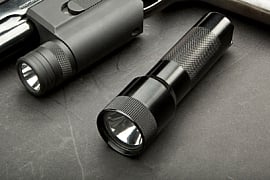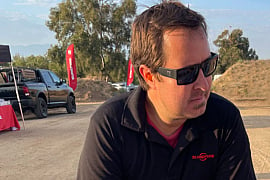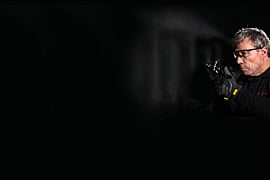Meet Khoi Pham of Team SureFire in person and you might never realize the fire that burns inside him to become one of the best competitive shooters on the planet.
At first glimpse the 27-year-old Californian comes off as a bright, happy and extremely enthusiastic SureFire employee. But catch him in action when the buzzer sounds at a United States Practical Shooting Association (USPSA)-sanctioned shooting match and you’ll get a very different sight picture. Pham is an extremely serious and capable shooter with the potential to make big waves in the sport. The talent and desire are there. The experience will come.

Pham was raised in a family of responsible gun owners, though he describes his competitive skills as largely self-taught. A graduate of California State University, Fullerton, with a BA in Business Management, he broke into the firearms industry by working his way up to assistant sales manager at a local gun shop before joining Surefire as an inside sales representative in 2019. However, it didn’t take long before his competitive shooting abilities were recognized within the company, prompting an invitation for him to join the elite Team SureFire shooting squad. In addition to his primary role, he now enjoys the honor of representing the SureFire brand while he aspires to achieve some lofty competitive goals he has set for himself.
Khoi, what got you into competitive shooting in the first place?
I’ve always wanted to be a competitive shooter. I grew up watching Rob Leatham Mike and Maggie Voigt, and Barry Dueck of Team SureFire, JJ Racaza, Bob Vogel, Frank Proctor, Max Michel, KC Eusebio – a bunch of them. The only thing that ever stopped me was time and money. I grew up shooting, for as long as I can remember, so money was definitely the biggest setback for me. After graduating college I could start working more, so I started pursuing the hobby.
In what divisions do you currently represent Team SureFire?
I mainly compete in USPSA (United States Practical Shooting Association). I started off in the Production division, which is basically your stock gun division with magazines limited to 10 rounds. That got kind of boring, so I moved to Open, which is your race division. The sky is the limit in terms of modifications and accessories that are allowed. You can use red dot sights, mag wells, compensators, standard-capacity magazines, gas pedals, etc., and there are no restrictions on the placement and orientation of holsters and magazine pouches. It’s a lot more fun, in my opinion, because you can really push the speed and shoot as fast as you can. And it’s also more focused on movement, which I like doing. There’s also less reloads, which makes it more fun. I love it, but I plan to move into other divisions later down the road.
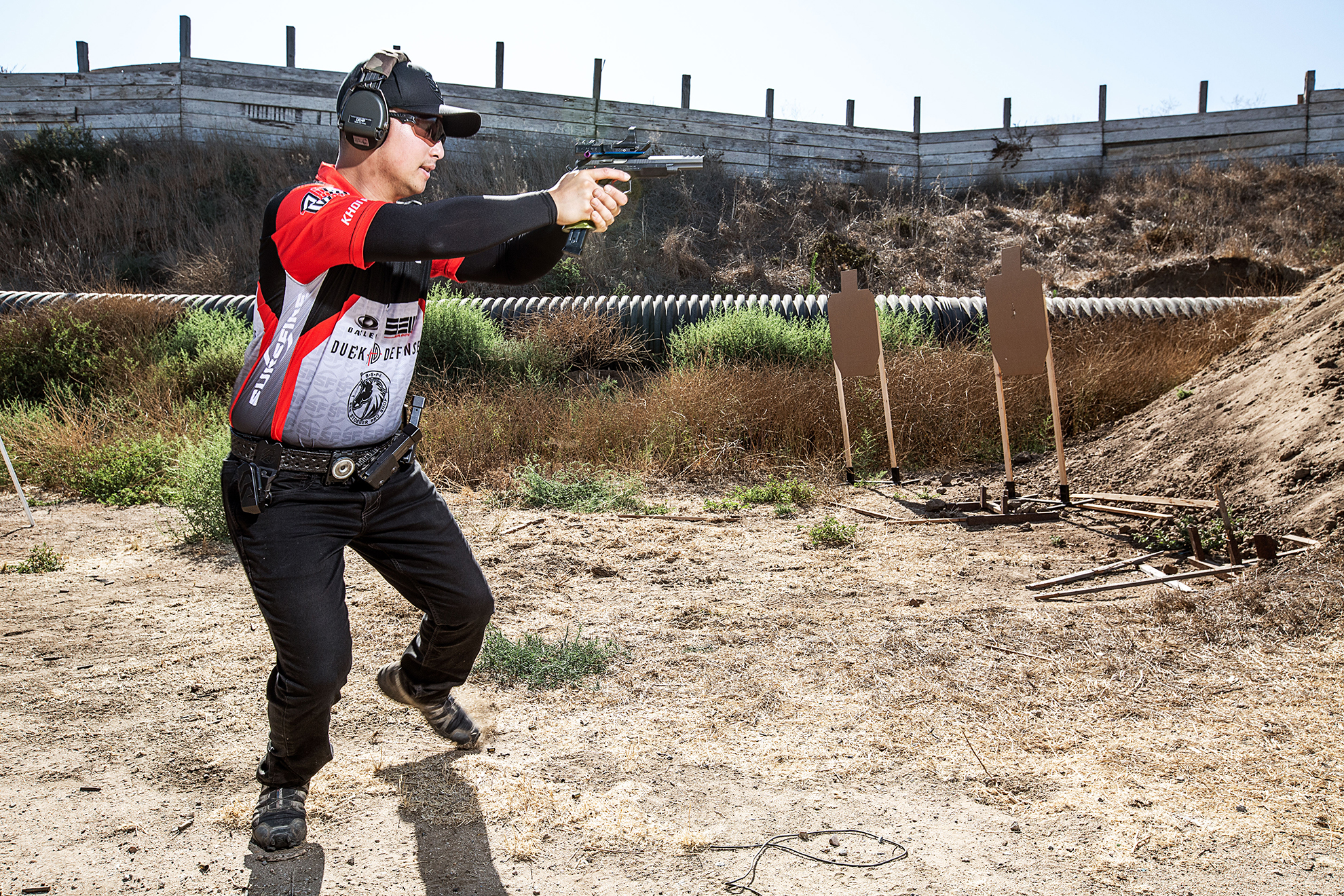
What’s the best result you’ve attained thus far?
Being that this is the first year I started shooting major matches, my portfolio is pretty thin at the moment [laughs]. I am definitely going to shoot more major matches in the 2020 season. But so far, I finished second in Open Division B Class at the 2019 Safariland Central California Top Gun Championships, a level 2 USPSA-sanctioned match. I was only off by like nine points and I had the guy, but I just got cocky and didn’t do as well as I should have. I also placed first in Open Division B Class and fourth overall in Open at the PRG (Prado Running Gun) 10th Anniversary Trophy match. At the 2019 Deadwood Boys Trophy Match I finished second overall in Open, which was pretty good. In local matches I’m finishing consistently in the top 10 overall. I shoot the Norco Running Gun matches in Chino Hills every week, so that’s basically my practice.
Any thoughts about following in the steps of Team SureFire guys like Barry Dueck and the late, great Mike Voigt, and moving to 3-Gun?
I have thought about it, but I’m still trying to master one gun right now! [laughs] Shooting 3-Gun is fun, but the thing is that I like shooting Open, and in 3-Gun the Open division gets quite expensive. With tricked-out rifles, shotguns, and handguns it’s pretty normal to spend upwards of 10 grand. But one of my main goals is to represent the United States in shooting sports. I know that Barry Dueck just represented Team SureFire at the IPSC World Rifle Shoot in Sweden. One day I hope to make it there and represent the U.S. or even represent the U.S. in the handgun portion of IPSC.
Have you ever thought about working toward the Olympics?
I tried skeet, and it’s kind of frustrating! [laughs] I shot long range for a little bit, and that’s fun. But I really like running and gunning, just hosing and flooring it, and I don’t believe there are any IPSC-style events in the Olympics. They should totally be added though!

When did you start competitive shooting?
Only a year ago, really. I shot my first USPSA match last July at the NRG [Norco Running Gun] match in Chino Hills. It’s crazy to see the amount of improvement and progress I’ve made so far. I would watch an old video of myself, and be like, “Wow! That was me back then?” Some guys have asked me if I’ve been shooting competitively for at least five years or if I have had a bunch of lessons, but I’ve never had the money for that. [laughs] I had a couple good friends who have helped me along, but mostly I taught myself. I just picked up whatever I information I could on my own, and I watched a lot of videos on YouTube. In fact, one of the best videos was a SureFire Field Notes episode featuring Mike Voigt. After that, it was just a lot of dry fire and practice.
I can imagine there was a high level of anxiety at your very first match.
It was through the roof. I had a stage plan, but that just went out the window once the buzzer went off. It was like, “Did I shoot that target?” So I’d shoot it again and then I’d realize that I already shot it. Then it was like, “What’d I just do that for?” [laughs] But it was really fun. It’s fun because you get to meet great people, step away from everyday life and get out and shoot. With every match you are tasked with breaking down each stage, where to move, where to reload, where you’re going to gas it and slow down, etc. The beauty of USPSA is that you can run the stage in any fashion you want whereas IDPA forces you to run each stage a certain way. There are different ways to run a stage in USPSA. It’s a mental game, and it’s physical, but it’s fun.

Would you recommend competitive shooting to others? No doubt the answer is yes, but what advice would you give for newbs to help them be grounded right out of the gate?
Definitely! Get out there! Probably the best tip I could give someone is to dry fire. A lot. It’s free, and it really helps you with your sight picture and other things. For every 100 rounds you put down range, you should dry fire at least 10 times that amount.
Get comfortable with your firearm. A lot of new shooters go in head-first without being comfortable with their firearm. That’s unsafe. The more acclimated you are with your firearm; the better your results are going to be. You’re going to be able to hit your reloads, follow through with your shots better, and your transitions will be easier. But if you’re unfamiliar with your firearm, you’re going to have a steeper learning curve to overcome. Another tip would be to come out and just watch. Most matches are free for viewers and are a great way to learn about the sport and maybe even receive tips before you actually start competing.
Having some grasp of the rules will also help. You don’t need to know everything before you start competing, but basic safety rules such as avoiding a ND [negligent discharge] or not breaking the 180 are things that I would recommend beforehand. Then just go out and try it. You’ll never know until you try. It seems intimidating at first, but it’s really fun. The first stage is always the hardest, but after that it’s smooth sailing.
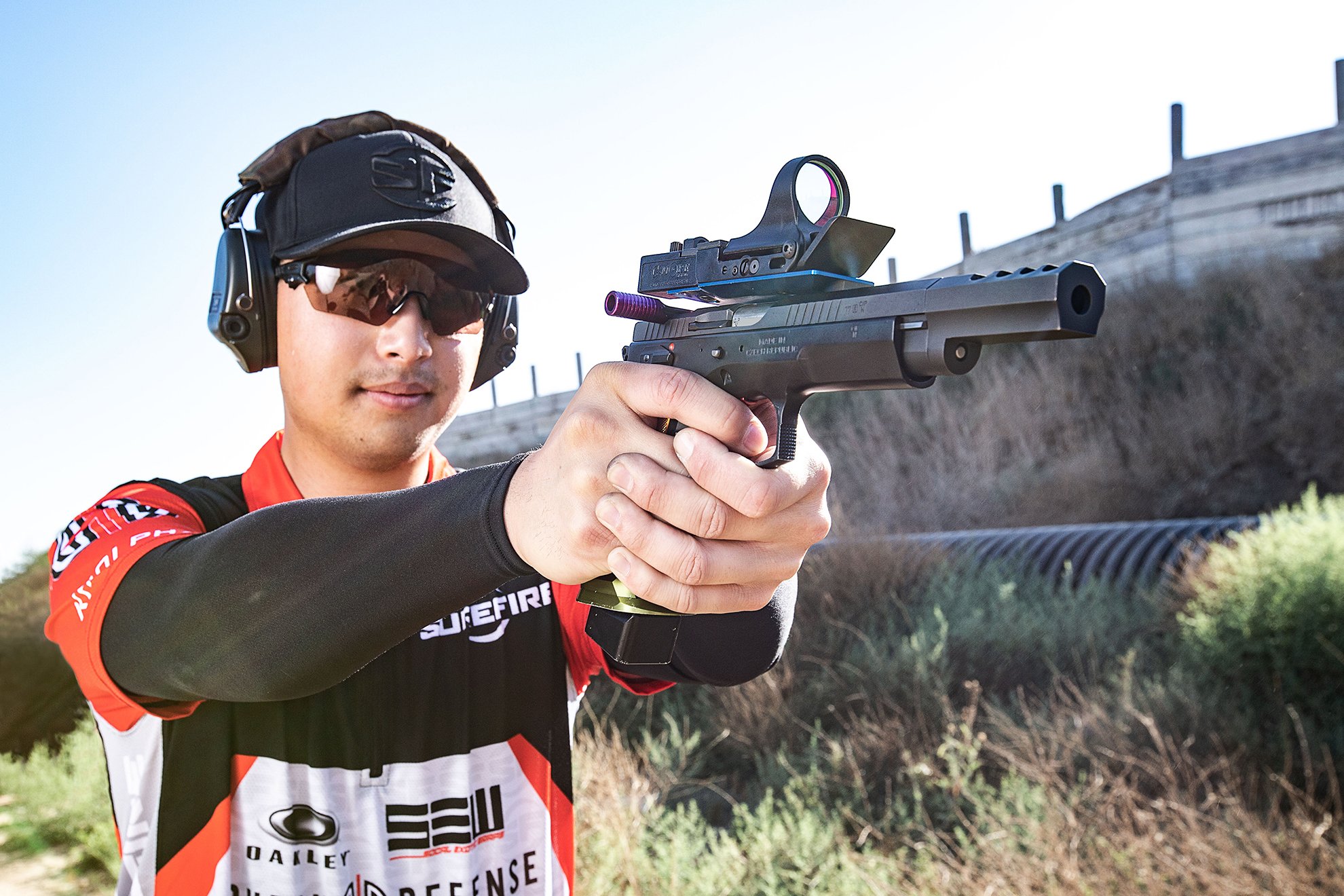
How receptive is the competitive shooting community to newcomers?
They’re really supportive, which is really good. At the local NRG (Norco Running Gun) matches we welcome new shooters and help them to grow in the sport. In fact one of the reasons why I continue to shoot competitively is because of all the great people you get to meet. I have met a lot of good friends by competing with them at shooting matches.
And I’m sure that camaraderie also benefits your current profession as well.
Sure. The biggest thing has been connecting with SureFire customers. I am currently handling Surefire’s domestic military and law enforcement accounts and sales. It’s great to be able to meet with our customer base, hear their feedback and build a strong relationship.
Did working at SureFire make you a fan of the brand, or was it a case of vice versa?
I was using SureFire products long before I started working here. My dad actually used their incandescent flashlights in the 1980s and ‘90s, and I just followed after him. I’ve never had a single malfunction or issue with any of SureFire products. Not only that, SureFire caters to different markets — ear protection, suppressors, weaponLights with IR and lasers, and even holsters. Flashlights are still our bread and butter, but we are a true one-stop shop. The LE and Mil guys know that SureFire is tried and true. What it boils down to is that if you need it, it’s there, and it’s going to work. It’s designed here and made here.
I’ve noticed that there seems to be a real fraternity among SureFire customers as well.
There is, although I wouldn’t say it’s elitist or anything like that. They just know that you get what you pay for, and it flat out works.
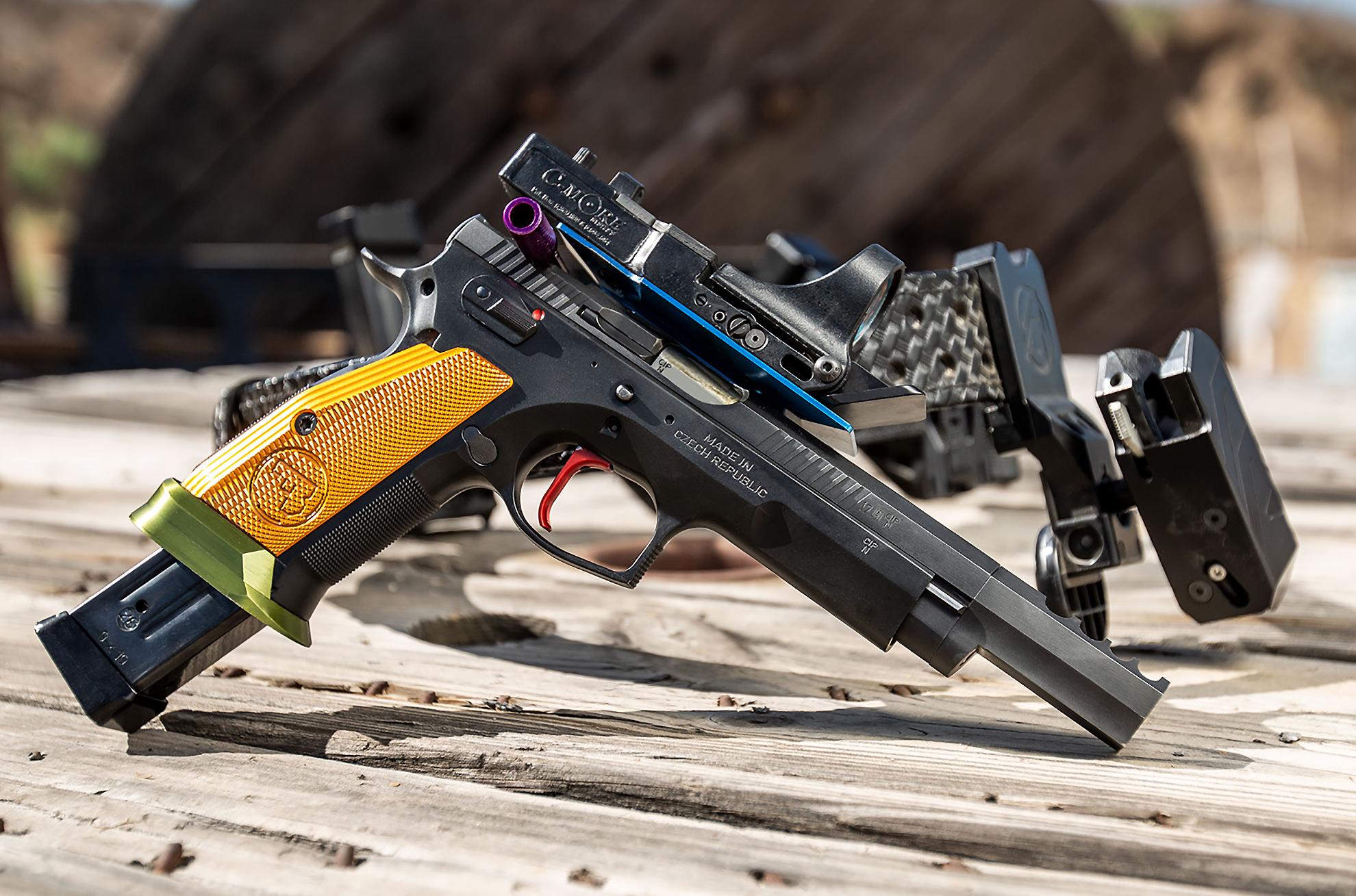
Speaking of equipment, break yours down for us.
Sure. When I started shooting in Production divison, I was using the CZ Shadow 2. It’s a great handgun because of its all-steel construction. It’s heavier but very ergonomic, and I think that’s an advantage over a Glock or a SIG because when you’re trying to run it fast the gun doesn’t move as much. Not only that, but you can tune the trigger to be sub-2 lbs., which is incredibly light and smooth. The majority of production shooters are using the CZ because of the trigger, the weight and how low the bore axis is in relation to your hand, which translates to less felt recoil.
My current Open gun is also a CZ. I’m using the Czechmate Parrot. It’s a full-on race gun. It has a compensator, C-More red dot, magwell which aids in faster reloads and the magazine carries 29 rounds. In Open you are really limited to the size of the magazine more so than the capacity of it — 170 millimeters is the longest length you can have, so guys will try to squeeze-in as many rounds as possible. I can get 29, which works for me. The trigger is set at about one pound and is strictly for competition. If you sneeze, the gun will go off. I am also looking at switching to 2011 variances like SVI [Strayer Voit Infinity], Limcat Custom, Atlas Gunworks and Akai Custom, but that’s like stepping up to a Lamborghini: It gets kind of expensive and requires a little more maintenance.
For ammo, I’m currently reloading my own as are most competitive shooters. I’m currently using Precision Delta’s 124GR JHP bullet and Winchester Autocomp powder for Open. One of the advantages of reloading your own ammo is that you can tailor it to your firearm and squeeze every little bit of accuracy out of it with very minimal recoil. Since I’m shooting Open, to be competitive I have to make “major power factor.” The formula to calculate power factor is: bullet weight x velocity / 1000. To make major power factor in USPSA, the average has to be higher than 165. What that basically means is that the bullet is traveling a lot faster than normal, around 1400 feet per second.
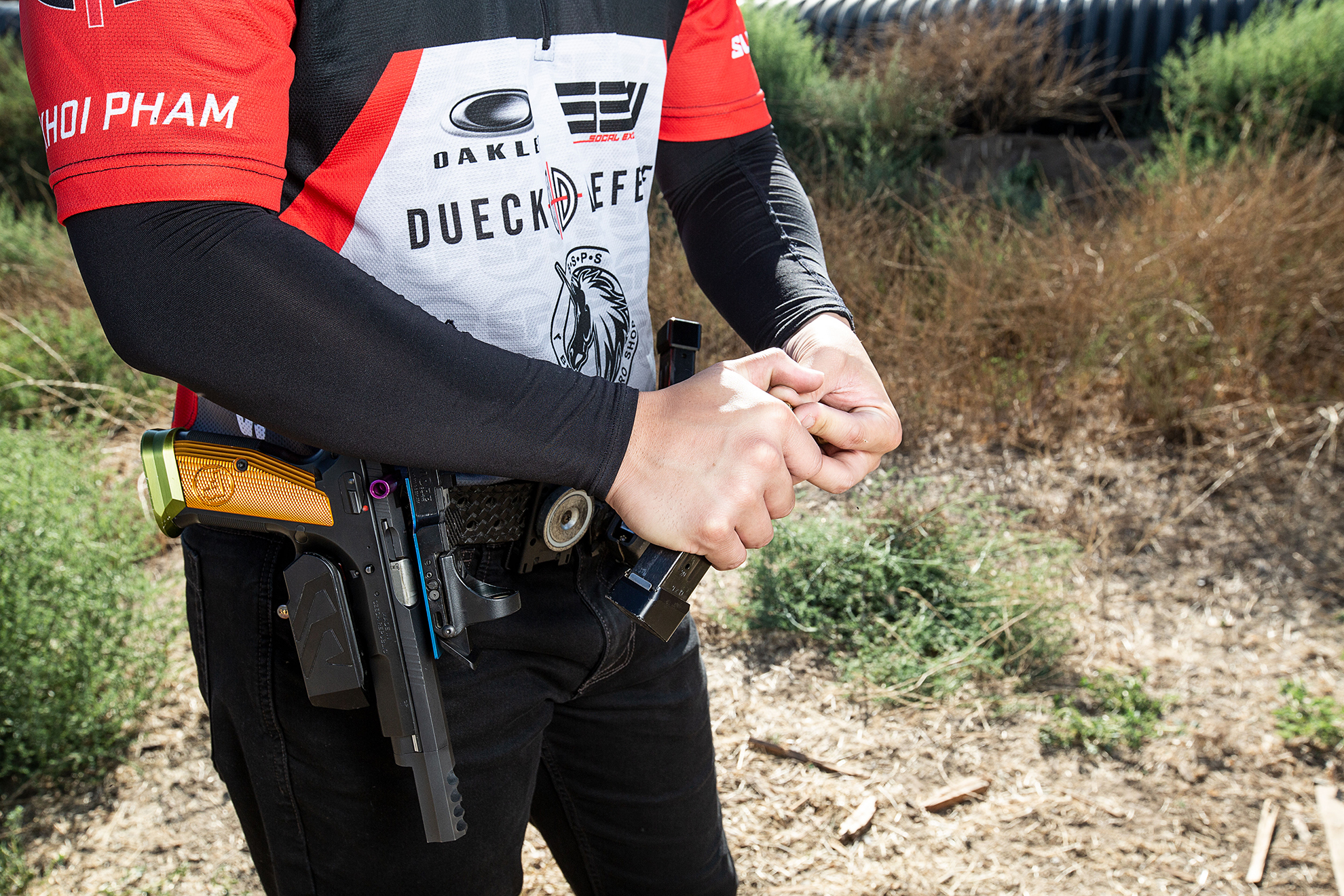
To give you a general idea, a normal factory 9 mm bullet is traveling around 1000-1100 feet per second. The idea of “major power factor” in competition is to even the playing field for competitors. In theory the more velocity the bullet has while traveling, the greater the recoil, which makes it harder for the competitor; therefore they should be given more points. But in reality, since it is Open division and everyone is using race guns with compensators, the extra velocity is negligible and actually works in favor for the competitor because it provides more gas to work the compensator and keeps the gun flat.
One of the horrors for Open shooters is finding out that their ammo does not meet major power factor at big matches because there is a chronograph that measures the velocity to maintain the integrity of the shooter and the sport. So the bottom line is that if you’re shooting Open, make sure your ammo meets major power factor.
I use Safariland’s ELS belt and magazine pouches. The ELS is very modular, so you can use it for 3-Gun. I like it because it is thick and it is rigid, so it doesn’t move around a lot.
For Production, I used a pretty standard kydex holster — nothing fancy. For my Open holster, I’m currently using the Double Alpha-X holster. I like it because it is very modular and you’re able to switch between different guns by changing the block inside of the holster. Not only that, the holster is very low profile and I’m able to get some pretty fast draws out of it.
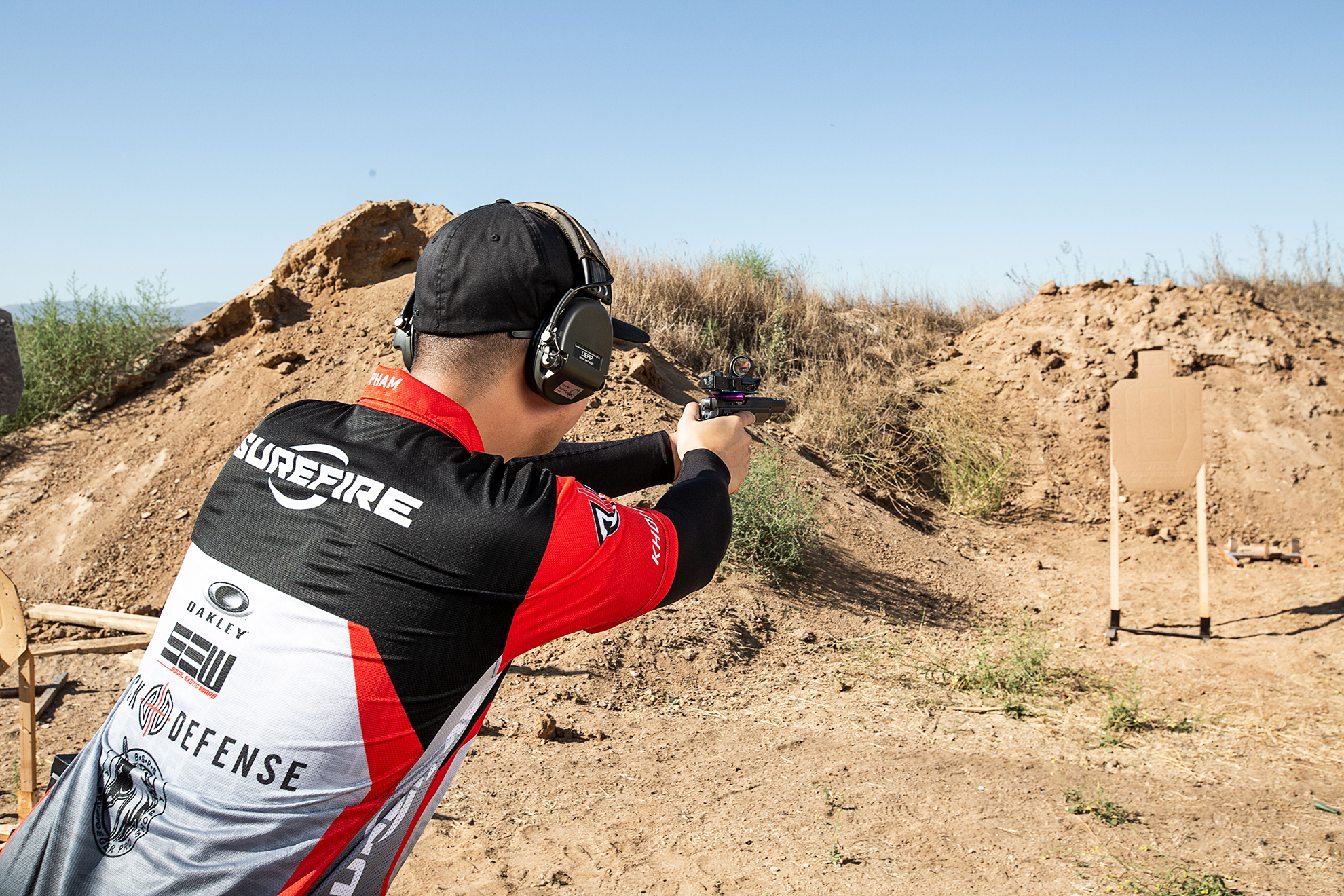
What SureFire products are you using?
EarPro, for sure. I love the EP7s, and I really recommend them for competition. They’re really durable and reliable. I tend to run the same pair longer than I should just because they’re so comfortable, but I change them often enough. I’ve used our WeaponLights, and I think I was one of the first ones to use our MasterFire holster in competitive shooting. I love how you can buy one light and then move it across different firearm platforms without having to change the holster. I love how fast you can draw with it. The only reason I don’t use it right now is because my current platform doesn’t have a rail. But it’s a great holster.
Do you ever shoot low-light matches?
There are some low-light matches. In fact, there is one that I’m planning on attending which is hosted by the Deadwood Boys club in Piru, California, later this year. It’s low-light/no-light, so you can use lights or night vision, which is perfect for our WeaponLights and the MasterFire system. It’s going to be completely different than what I am used to but it will be a good change of pace and good practice.
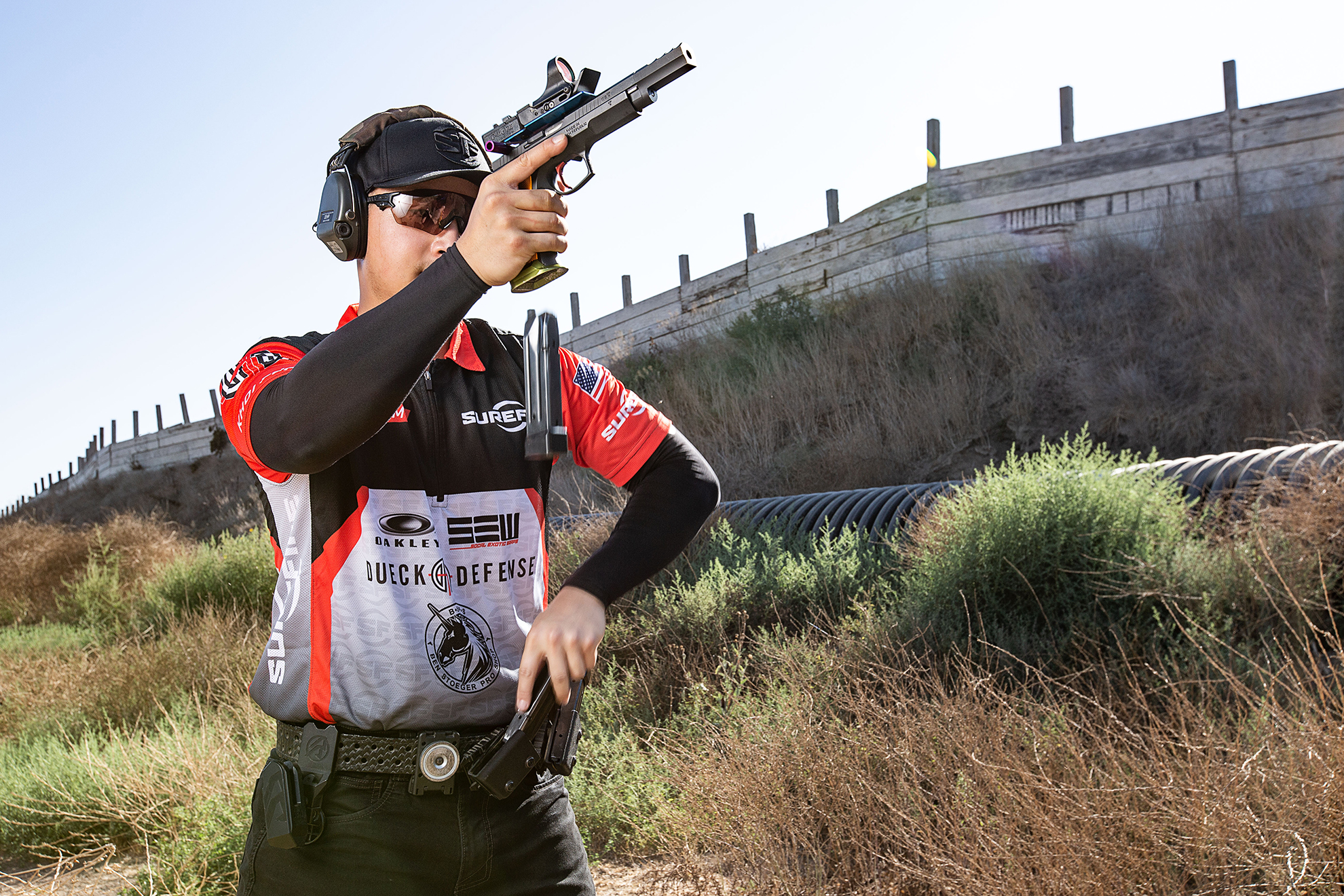
Is there anyone you’d like to thank for helping you in your progression within the sport?
Definitely, first and foremost I would like to thank Surefire for supporting and fueling my passion. It’s great to be able to work for and represent a company that not only supports you but helps build you up as an individual as well as in the sport. I have also been fortunate enough to meet a lot of good people at SureFire, such as John Marcelo, who has helped me along the way. John is helping me a lot with conditioning and footwork. Contrary to popular belief, you have to run and your footwork has to be on point. Otherwise you can have a lot of wasted movement that can cost you time.
Special thanks to Luis Bersamin and Mark Proner for all the help and motivation. Huge thanks to Alex Hogan for helping tune and developing my match ammo. Thank you to Claudia Vidanes and the Vidanes family for hosting the local Norco Running Gun matches every week in Chino Hills. The family has been very welcoming, and had it not been for their matches, I would have never met the amazing people whom I have had the pleasure of calling friends. The NRG matches are very challenging and are good practice for the major matches. Lastly, I would like to thank all my friends and family who have been supporting and pushing me to become the best that I can be.
That’s something I’m definitely working on. There’s that quote that says, “Failing to prepare is preparing to fail.” That’s not an option for me.

